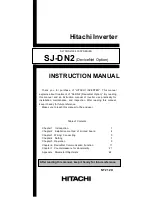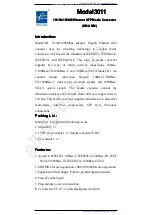
CHAPTER 3 WIRING, CONNECTING
6
3.3 Wiring note
1. Installing the cable to Network connector must be done after checking the power supply off.
2. Wiring should not have bare cables exposed between connector contacts.
3. Network cables should be fixed without tension. Cables fixed under tension have potential of causing a
communication fault by removing a connector.
4. Provide a communication power source (DC24V).
5. The terminating resistor is not built-in in the unit. Please provide it.
6. Ensure external emergency stop measures are taken to stop the inverter, in the event of a network fault.
(a) Remove the Power supply of the Inverter when the network master detects a communication fault.
(b) When the master detects a communication fault, turn on the intelligent input terminal which would
be allocated (FRS), (RS) and/or (EXT) function.
(c) Setting command P045.
Regarding this setting, the inverter is tripped, deceleration or free run stop when it detects a
communication fault by itself. (Factory initialization of command P045 is trip after deceleration stop (code:
01).) See “4.2 Setting of the Inverter” and “4.3 Explanation of additional parameters” about explanation of
P045 (Inverter action when communication error).
7. Basic components for construction of DeviceNet application system are shown as bellow.
Refer to the master’s description manuals when DeviceNet Network system comes into operation.
HITACHI
Inverter
Inverter
Terminating
Resistor (121 )
Terminating
resistor
(121 )
Multi-port Tap
Other slave units
Power
Supply
DC24V
DeviceNet Master UNIT (PLC)
Trunk line
Trunk line
Drop
line
Multiple Node branching drop line.
Figure 3-2 Example of components for construction of DeviceNet application
Configurater (PC)
HITACHI











































